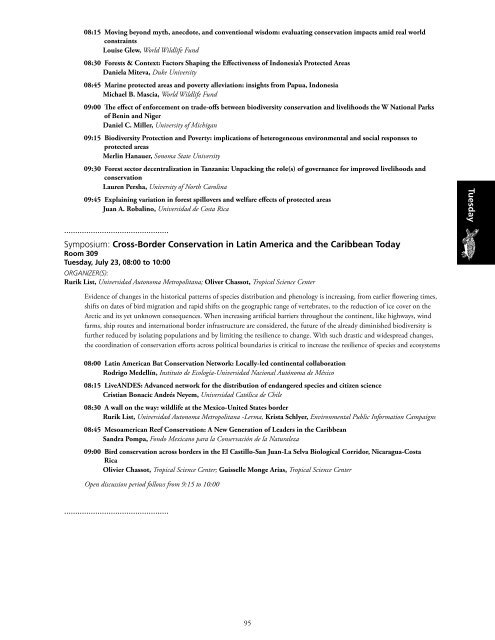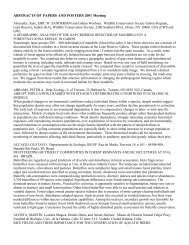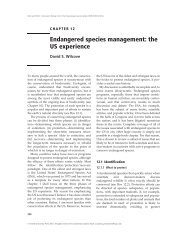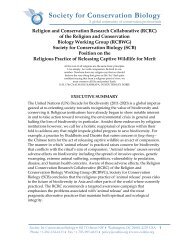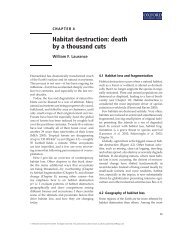ICCB 2013 Program - Society for Conservation Biology
ICCB 2013 Program - Society for Conservation Biology
ICCB 2013 Program - Society for Conservation Biology
You also want an ePaper? Increase the reach of your titles
YUMPU automatically turns print PDFs into web optimized ePapers that Google loves.
08:15 Moving beyond myth, anecdote, and conventional wisdom: evaluating conservation impacts amid real world<br />
constraints<br />
Louise Glew, World Wildlife Fund<br />
08:30 Forests & Context: Factors Shaping the Effectiveness of Indonesia’s Protected Areas<br />
Daniela Miteva, Duke University<br />
08:45 Marine protected areas and poverty alleviation: insights from Papua, Indonesia<br />
Michael B. Mascia, World Wildlife Fund<br />
09:00 The effect of en<strong>for</strong>cement on trade-offs between biodiversity conservation and livelihoods the W National Parks<br />
of Benin and Niger<br />
Daniel C. Miller, University of Michigan<br />
09:15 Biodiversity Protection and Poverty: implications of heterogeneous environmental and social responses to<br />
protected areas<br />
Merlin Hanauer, Sonoma State University<br />
09:30 Forest sector decentralization in Tanzania: Unpacking the role(s) of governance <strong>for</strong> improved livelihoods and<br />
conservation<br />
Lauren Persha, University of North Carolina<br />
09:45 Explaining variation in <strong>for</strong>est spillovers and welfare effects of protected areas<br />
Juan A. Robalino, Universidad de Costa Rica<br />
...............................................<br />
Symposium: Cross-Border <strong>Conservation</strong> in Latin America and the Caribbean Today<br />
Room 309<br />
Tuesday, July 23, 08:00 to 10:00<br />
Organizer(s):<br />
Rurik List, Universidad Autonoma Metropolitana; Oliver Chassot, Tropical Science Center<br />
Tuesday<br />
Evidence of changes in the historical patterns of species distribution and phenology is increasing, from earlier flowering times,<br />
shifts on dates of bird migration and rapid shifts on the geographic range of vertebrates, to the reduction of ice cover on the<br />
Arctic and its yet unknown consequences. When increasing artificial barriers throughout the continent, like highways, wind<br />
farms, ship routes and international border infrastructure are considered, the future of the already diminished biodiversity is<br />
further reduced by isolating populations and by limiting the resilience to change. With such drastic and widespread changes,<br />
the coordination of conservation ef<strong>for</strong>ts across political boundaries is critical to increase the resilience of species and ecosystems<br />
08:00 Latin American Bat <strong>Conservation</strong> Network: Locally-led continental collaboration<br />
Rodrigo Medellín, Instituto de Ecología-Universidad Nacional Autónoma de México<br />
08:15 LiveANDES: Advanced network <strong>for</strong> the distribution of endangered species and citizen science<br />
Cristian Bonacic Andrés Neyem, Universidad Católica de Chile<br />
08:30 A wall on the way: wildlife at the Mexico-United States border<br />
Rurik List, Universidad Autonoma Metropolitana -Lerma, Krista Schlyer, Environmental Public In<strong>for</strong>mation Campaigns<br />
08:45 Mesoamerican Reef <strong>Conservation</strong>: A New Generation of Leaders in the Caribbean<br />
Sandra Pompa, Fondo Mexicano para la Conservación de la Naturaleza<br />
09:00 Bird conservation across borders in the El Castillo-San Juan-La Selva Biological Corridor, Nicaragua-Costa<br />
Rica<br />
Olivier Chassot, Tropical Science Center; Guisselle Monge Arias, Tropical Science Center<br />
Open discussion period follows from 9:15 to 10:00<br />
...............................................<br />
95


